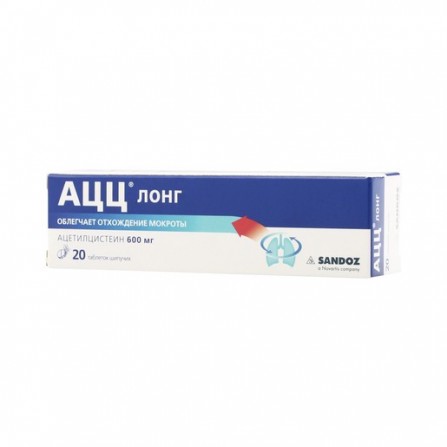ATC Long effervescent pills 600mg 20 pcs
Condition: New product
1000 Items
Rating:
Be the first to write a review!

More info
Active ingredients
Acetylcysteine
Release form
Pills
Composition
Acetylcysteine 600 mg. Auxiliary substances: anhydrous citric acid - 625 mg, sodium hydrocarbonate - 327 mg, sodium carbonate - 104 mg, mannitol - 72.8 mg, lactose - 70 mg, ascorbic acid - 75 mg, sodium cyclamate - 30.75 mg, sodium saccharinate dihydrate - 5 mg, sodium citrate dihydrate - 0.45 mg, blackberry flavoring B - 40 mg.
Pharmacological effect
Mucolytic drug. Acetylcysteine is a derivative of the amino acid cysteine. It has a mucolytic effect, facilitates sputum discharge due to a direct effect on the rheological properties of sputum. The action is due to the ability to break the disulfide bonds of the mucopolysaccharide chains and cause the depolymerization of the mucoproteins of sputum, which leads to a decrease in the viscosity of the sputum. The drug retains activity in the presence of purulent sputum. It has an antioxidant effect, due to the ability of its reactive sulfhydryl groups (SH-groups) to bind with oxidative radicals and, thus, neutralize them. In addition, acetylcysteine contributes to the synthesis of glutathione, an important component of the antioxidant system and chemical detoxification of the body. The antioxidant effect of acetylcysteine increases the protection of cells against the damaging effects of free radical oxidation, which is characteristic of an intense inflammatory reaction. With prophylactic use of acetylcysteine, a decrease in the frequency and severity of exacerbations in patients with chronic bronchitis and cystic fibrosis has been observed.
Pharmacokinetics
Absorption and distribution: Absorption is high. Bioavailability when administered is 10%, due to the pronounced effect of the first passage through the liver. The time to reach Cmax in plasma is 1-3 hours. Binding to plasma proteins is 50%. It penetrates the placental barrier. Data on the ability of acetylcysteine to penetrate the BBB and excreted in breast milk are not available. Metabolism and excretion: It is rapidly metabolized in the liver to form a pharmacologically active metabolite, cysteine, as well as diacetylcysteine, cystine, and mixed disulfides. Excreted by the kidneys as inactive metabolites (inorganic sulphates, diacetylcysteine). T1 / 2 is about 1 hour.Pharmacokinetics in special clinical situations: Impaired liver function leads to a lengthening of T1 / 2 up to 8 h.
Indications
- diseases of the respiratory system, accompanied by the formation of viscous sputum difficult to separate (acute and chronic bronchitis, obstructive bronchitis, tracheitis, laryngotracheitis, pneumonia, lung abscess, bronchiectasis, bronchial asthma, COPD, bronchiolitis, mucoviscidosis) - acute and chronic, bronchial asthma, COPD, bronchiolitis, mucoviscidosis - acute and chronic, chronic bronchial asthma, COPD, bronchiolitis, mucous fibrosis;
Contraindications
- gastric ulcer and duodenal ulcer in the acute phase — hemoptysis — pulmonary hemorrhage — pregnancy — lactation period (breastfeeding) —children age up to 14 years old (ACC; Long) —child age up to 2 years (ACC; 100 and ACC; 200) - Lactase deficiency, lactose intolerance, glucose-galactose malabsorption - hypersensitivity to the drug components. With caution, the drug should be used in patients with gastric ulcer and duodenal ulcer in anamnesis with bronchial asthma, obstructive Ovarian bronchitis, hepatic and / or renal insufficiency, histamine intolerance (long-term use of the drug should be avoided, because acetylcysteine affects histamine metabolism and can lead to signs of intolerance, such as headache, vasomotor rhinitis, pruritus), esophageal varices of the esophagus, adrenal diseases arterial hypertension.
Dosage and administration
The drug is taken orally after a meal. Tablets should be taken immediately after dissolution, in exceptional cases, you can leave the finished solution for 2 hours. The additional liquid intake enhances the mucolytic effect of the drug. Adults and adolescents over 14 years old are advised to prescribe the drug at 200 mg 2-3 times / day (ACC; 100 or ACC; 200), which corresponds to 400-600 mg of acetylcysteine per day, or 600 mg each (ACC; Long) 1 time / days Children aged 6 to 14 years are recommended to take 1 tab. (ACC; 100) 3 times / day, or 2 tab. (ACC; 100) or 1 tab. (ACC; 200) 2 times / day, which corresponds to 300-400 mg of acetylcysteine per day. Children aged 2 to 5 years, the drug is recommended to take 1 tab. (ACC; 100) or 1/2 tab. (ACC; 200) 2-3 times / day, which corresponds to 200-300 mg of acetylcysteine per day. For cystic fibrosis, children over 6 years old are recommended to take 2 tab. (ACC; 100) or 1 tab. (ACC; 200) 3 times / day, which corresponds to 600 mg of acetylcysteine per day.Children aged 2 to 6 years - 1 tab. (ACC; 100) or 1/2 tab. (ACC; 200) 4 times / day, which corresponds to 400 mg of acetylcysteine per day. For short-term colds, the duration of treatment is 5-7 days. In chronic bronchitis and cystic fibrosis, the drug should be used longer to prevent infections.




